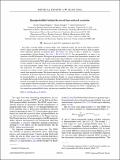| dc.contributor.author | Yunger Halpern, Nicole | |
| dc.contributor.author | Dressel, Justin | |
| dc.contributor.author | Swingle, Brian Gordon | |
| dc.date.accessioned | 2018-04-12T18:18:07Z | |
| dc.date.available | 2018-04-12T18:18:07Z | |
| dc.date.issued | 2018-04 | |
| dc.date.submitted | 2017-04 | |
| dc.identifier.issn | 2469-9926 | |
| dc.identifier.issn | 2469-9934 | |
| dc.identifier.uri | http://hdl.handle.net/1721.1/114677 | |
| dc.description.abstract | Two topics, evolving rapidly in separate fields, were combined recently: the out-of-time-ordered correlator (OTOC) signals quantum-information scrambling in many-body systems. The Kirkwood-Dirac (KD) quasiprobability represents operators in quantum optics. The OTOC was shown to equal a moment of a summed quasiprobability [Yunger Halpern, Phys. Rev. A 95, 012120 (2017)2469-992610.1103/PhysRevA.95.012120]. That quasiprobability, we argue, is an extension of the KD distribution. We explore the quasiprobability's structure from experimental, numerical, and theoretical perspectives. First, we simplify and analyze Yunger Halpern's weak-measurement and interference protocols for measuring the OTOC and its quasiprobability. We decrease, exponentially in system size, the number of trials required to infer the OTOC from weak measurements. We also construct a circuit for implementing the weak-measurement scheme. Next, we calculate the quasiprobability (after coarse graining) numerically and analytically: we simulate a transverse-field Ising model first. Then, we calculate the quasiprobability averaged over random circuits, which model chaotic dynamics. The quasiprobability, we find, distinguishes chaotic from integrable regimes. We observe nonclassical behaviors: the quasiprobability typically has negative components. It becomes nonreal in some regimes. The onset of scrambling breaks a symmetry that bifurcates the quasiprobability, as in classical-chaos pitchforks. Finally, we present mathematical properties. We define an extended KD quasiprobability that generalizes the KD distribution. The quasiprobability obeys a Bayes-type theorem, for example, that exponentially decreases the memory required to calculate weak values, in certain cases. A time-ordered correlator analogous to the OTOC, insensitive to quantum-information scrambling, depends on a quasiprobability closer to a classical probability. This work not only illuminates the OTOC's underpinnings, but also generalizes quasiprobability theory and motivates immediate-future weak-measurement challenges. | en_US |
| dc.description.sponsorship | National Science Foundation (U.S.) (Grant PHY- 0803371) | en_US |
| dc.description.sponsorship | United States. Army Research Office (Grant W911NF-14-1-0003) | en_US |
| dc.publisher | American Physical Society | en_US |
| dc.relation.isversionof | http://dx.doi.org/10.1103/PhysRevA.97.042105 | en_US |
| dc.rights | Article is made available in accordance with the publisher's policy and may be subject to US copyright law. Please refer to the publisher's site for terms of use. | en_US |
| dc.source | American Physical Society | en_US |
| dc.title | Quasiprobability behind the out-of-time-ordered correlator | en_US |
| dc.type | Article | en_US |
| dc.identifier.citation | Yunger Halpern, Nicole et al. "Quasiprobability behind the out-of-time-ordered correlator." Physical Review A 97, 4 (April 2018): 042105 © 2018 American Physical Society | en_US |
| dc.contributor.department | Massachusetts Institute of Technology. Department of Physics | en_US |
| dc.contributor.mitauthor | Swingle, Brian Gordon | |
| dc.relation.journal | Physical Review A | en_US |
| dc.eprint.version | Final published version | en_US |
| dc.type.uri | http://purl.org/eprint/type/JournalArticle | en_US |
| eprint.status | http://purl.org/eprint/status/PeerReviewed | en_US |
| dc.date.updated | 2018-04-10T18:00:29Z | |
| dc.language.rfc3066 | en | |
| dc.rights.holder | American Physical Society | |
| dspace.orderedauthors | Yunger Halpern, Nicole; Swingle, Brian; Dressel, Justin | en_US |
| dspace.embargo.terms | N | en_US |
| mit.license | PUBLISHER_POLICY | en_US |
